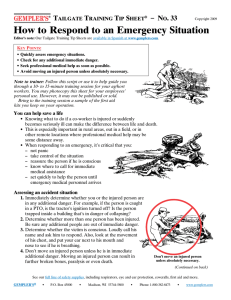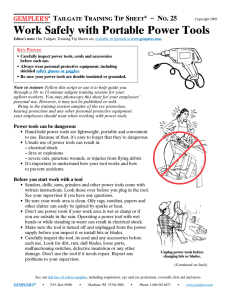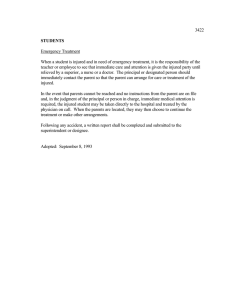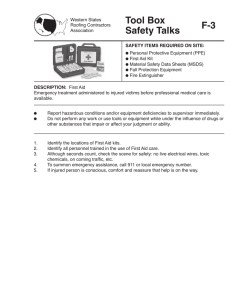How To Handle Emergency Situations
advertisement
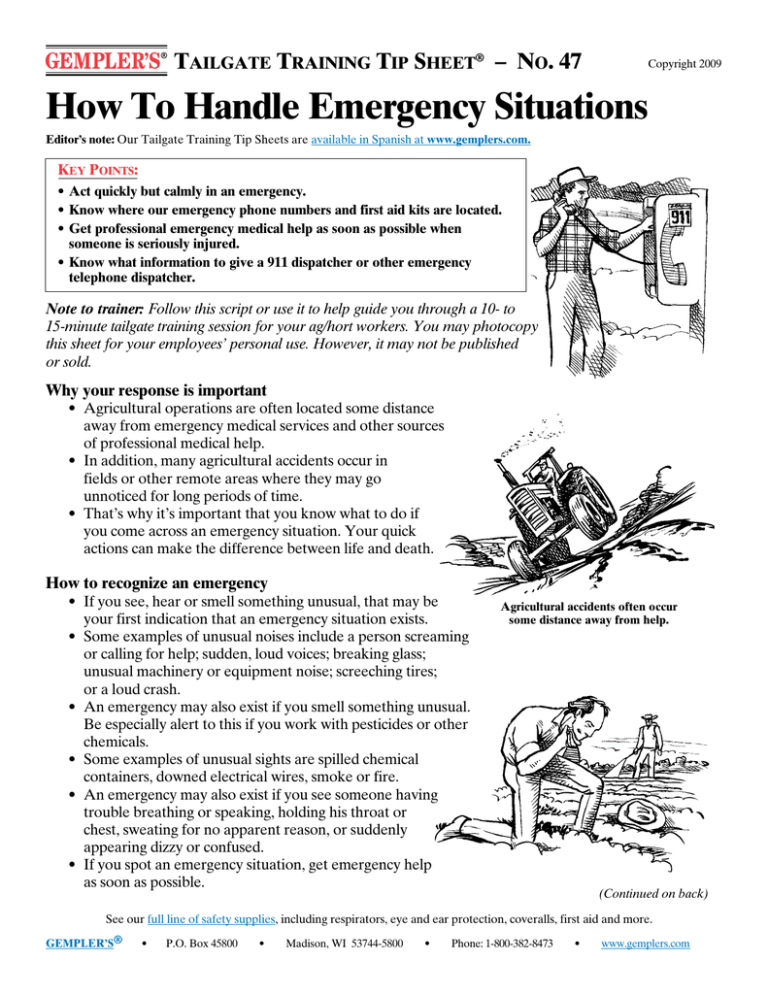
Tailgate Training Tip Sheet® – No. 47 Copyright 2009 How To Handle Emergency Situations Editor’s note: Our Tailgate Training Tip Sheets are available in Spanish at www.gemplers.com. Key Points: •Act quickly but calmly in an emergency. •Know where our emergency phone numbers and first aid kits are located. •Get professional emergency medical help as soon as possible when someone is seriously injured. •Know what information to give a 911 dispatcher or other emergency telephone dispatcher. Note to trainer: Follow this script or use it to help guide you through a 10- to 15-minute tailgate training session for your ag/hort workers. You may photocopy this sheet for your employees’ personal use. However, it may not be published or sold. Why your response is important • Agricultural operations are often located some distance away from emergency medical services and other sources of professional medical help. • In addition, many agricultural accidents occur in fields or other remote areas where they may go unnoticed for long periods of time. • That’s why it’s important that you know what to do if you come across an emergency situation. Your quick actions can make the difference between life and death. How to recognize an emergency • If you see, hear or smell something unusual, that may be your first indication that an emergency situation exists. • Some examples of unusual noises include a person screaming or calling for help; sudden, loud voices; breaking glass; unusual machinery or equipment noise; screeching tires; or a loud crash. • An emergency may also exist if you smell something unusual. Be especially alert to this if you work with pesticides or other chemicals. • Some examples of unusual sights are spilled chemical containers, downed electrical wires, smoke or fire. • An emergency may also exist if you see someone having trouble breathing or speaking, holding his throat or chest, sweating for no apparent reason, or suddenly appearing dizzy or confused. • If you spot an emergency situation, get emergency help as soon as possible. Agricultural accidents often occur some distance away from help. (Continued on back) See our full line of safety supplies, including respirators, eye and ear protection, coveralls, first aid and more. GEMPLER’S® • P.O. Box 45800 • Madison, WI 53744-5800 • Phone: 1-800-382-8473 • www.gemplers.com Tailgate Training Tip Sheet® – No. 47 (continued) Copyright 2009 How To Handle Emergency Situations A few important tips 1.Know where our emergency telephone numbers are located. Note to trainer: Tell trainees whether you have 911 in your area, and where that and other emergency numbers are posted. 2.Know where our first aid kits are located and what is in them. Note to trainer: Show trainees a first aid kit and go through the contents with them. 3.Stay calm when you come across an emergency. 4.Quickly assess the situation. If someone is hurt, make sure both you and the injured person are out of immediate danger. For example, if someone is caught in a PTO, turn the power off if you can safely do so. Warning: Never touch a downed power line. Don’t touch a person who has come into contact with a power line until the power has been turned off. If you need to move the person, use a wooden pole or other non-conducting object. 5.Call for professional emergency medical help as soon as possible. Don’t move a person with injuries to the head, neck or back unless he is in immediate danger. Administer CPR if the person isn’t breathing and you have been trained in CPR. 6.If another person is with you, send that person to call the emergency medical services while you stay with the injured party. Reassure the injured person. Information to give an emergency dispatcher • the location of the emergency and how to get there • what happened and how many people are injured • what type of first aid is being given • what additional hazards exist • your name and the number you are calling from • whether someone will meet the emergency medical services by the road or at a remote location Are there any questions? Note to trainer: Take time to answer trainees’ questions. Then review the Emergency Response Do’s and Don’ts. EMERGENCY RESPONSE DO’S AND DON’TS DO: • M ake sure someone knows where you are at all times, and have someone periodically check on you. • K now who to call for professional emergency medical help and what information will be needed. DON’T: • M ove a person with head, neck or back injuries unless he is in immediate danger. • F orget to tell a supervisor if a first aid kit needs to be restocked. See our full line of safety supplies, including respirators, eye and ear protection, coveralls, first aid and more. GEMPLER’S® • P.O. Box 45800 • Madison, WI 53744-5800 • Phone: 1-800-382-8473 • www.gemplers.com
